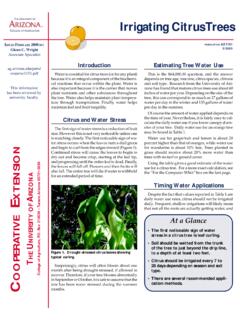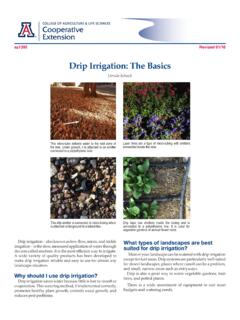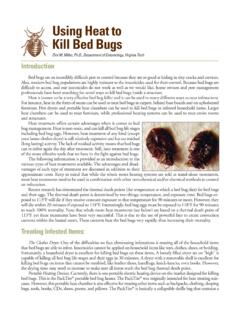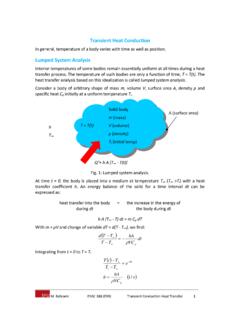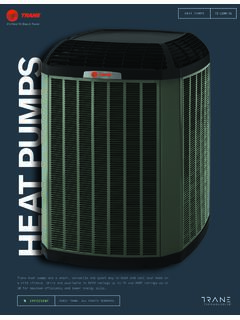Transcription of Protecting a Citrus Tree from Cold - University of Arizona
1 ISSUED MARCH 2001 BY:Glenn C. WrightAssociate informationhas been reviewed byuniversity EXTENSIONTHE University OF ARIZONAC ollege of Agriculture and Life Sciences, Box 210036 Tucson, Arizona 85721-0036 Protecting a Citrus Treefrom ColdPUBLICATION AZ12223/2001 IntroductionCitrus trees are not particularly cold hardy. Thisfact is one of the primary reasons for the existenceof the Citrus industry in Southern Arizona . None-theless, freezing temperatures are likely, and it isprudent for homeowners to take trees are most likely to survive coldtemperatures if they are planted in the properlocation. The USDA has divided the US into elevenplant hardiness zones based on 10 F averageannual minimum temperature1 ranges.
2 Zones 2through 10 are further subdivided (a and b) whichrepresent 5 F differences within each 10 F Arizona , Citrus may be safely grown in zone 10a,where average annual minimum temperaturesrange from 30 to 35 F, and in zone 9b, where averageannual minimum temperatures range from 25 to30 F. In zone 9a (20 to 25 F), Citrus may be grown inareas with proper cold air drainage. These areasinclude the slopes surrounding Tucson, and someareas of Pinal County. Bottomland areas withinzone 9a would not be acceptable, as cold air willaccumulate. Citrus planted in the Rillito Creek andGila River valleys of zone 9a, are highly susceptibleto frost in elevation, slope of the land, degreeof urbanization (presence of concrete and asphalt),and other factors affect the number of frost-free daysin any particular location.
3 Average first frost date,average last frost date, average daily winterminimum temperature and the record lowtemperature for several Citrus growing areas areshown in Table 1. These temperatures and datesshould be taken as a general guide only. Taketemperature readings in your location and comparethem to the temperature reported in the resources available on the Internet areshown on page 2. Use this information to predictthe impact of forecasted freezes. Your location maybe several degrees warmer or colder than thetemperature reported on the a Glance Frosts are more common thanfreezes in Arizona .
4 Site selection, proper variety androotstock and tree acclimation arethe most important defenses againstcold temperatures. Covering, supplemental heating, orirrigating may protect trees. Avoid pruning a cold damaged treeuntil , warmth, more warmth! For we aredying of cold, and not darkness. It is not the nightthat kills, but the frost. Miguel de UnamunoFigure 1. USDA plant hardiness zones for The University of Arizona Cooperative ExtensionHeat Accumulation and LossHeat may be transmitted from one material to another orfrom one place to another by three processes: conduction,convection, and radiation.
5 When your hand is warmed bya cup of hot coffee, heat is transferred by is the transfer of heat by the movement ofheated liquid or gas. Radiation is movement of heat fromone object to another without being physically is how the earth receives the sun s energy, how cropslose heat at night. The sun warms the earth by day and thesolid objects, such as plants, accumulate the heat and passit on to the air. The warmer air rises and is replaced bycooler air from above, and the atmosphere is the night, heat is lost from plants and other solidobjects to the atmosphere. When the night is clear, plantswill lose heat to the air, until they are cooler than thesurrounding air.
6 Water vapor in the form of clouds andCO2 block heat loss to the outer atmosphere. That is whycloudy winter nights are often warmer than the layers of air closer to the ground are colder thanupper layers, this is known as an inversion (Fig. 2). Lightwinds will often keep inversion layers from forming, allow-ing the plants to stay and FreezesThe great majority of the cold events in Arizona are frosts,which occur when conditions are calm and clear, and aninversion exists. Frosts are also more likely when the air isdry. Dry air is subject to high day to night a frost, sub-freezing temperatures rarely last morethan a few hours or drop below 20 F.
7 Attempts to protectcitrus from frost are often freeze can be much more severe than a frost. An advec-tive, or windborne, freeze occurs when an arctic cold airmass moves into an area bringing freezing to Florida and Texas, freezes are relatively un-common in Arizona . Most arctic cold fronts stay north ofSouthern Arizona , or travel east of the Rocky speeds are usually above 5 mph and clouds may bepresent. Freezes may last for several days. Attempts to pro-tect trees are generally not very successful under these , FSurface22242832363632282422 Figure 2. Inversion data resources on the InternetNational Weather Service: Meteorological Network: 1.
8 Frost-related weather data for several Arizona locations ( F).Location andUSDA zoneAvg. Date ofFirst FrostAvg. Date ofLast FrostAvg. Min. Temp.(Dec. Feb.)Record MinimumTemperature andYearBullhead City (10a)Dec. 19thJan. (1990)Deer Valley (9b)Nov. 30thFeb. (1971)Mesa (9b)Nov. 27thFeb. (1950)Parker (9b)Nov. 30thFeb. (1911)Phoenix (9b)Dec. 27thJan. (1950)Tucson (9a)Nov. 28thMar. (1949)Yuma (10a)Dec. 23rdFeb (1937)The University of Arizona Cooperative Extension 3 Long-term Cold Protection StrategiesThe four most important cold protection strategies avail-able to the homeowner should be taken prior to the frost orfreeze.
9 These include selecting the proper Citrus tree varietyand rootstock for the location, selecting the proper plantingsite, and allowing the tree to acclimate to the SELECTIONNot all Citrus varieties are equally cold hardy. Trifoliateorange, a deciduous, inedible ornamental Citrus tree cansurvive temperatures as low as 5 F. Kumquats are alsoquite cold hardy, as are Satsuma mandarins. Sour or-ange, tangerines and tangelos, sweet and navel orangesand grapefruit trees are partially cold hardy, and maysurvive temperatures as low as 20 F without significantdamage. Lemon, lime and citron trees are the least coldtolerant and will suffer at least some damage when tem-peratures drop below 25 ripening varieties can also be planted, so that thefruit may be harvested before cold weather arrives.
10 Someexamples include Satsuma mandarin, Fallglo manda-rin, Hamlin orange, Marrs orange, and Fukumoto navel SELECTIONSome rootstocks impart significant cold hardiness to thetree. Unfortunately, homeowners seldom have a choice ofrootstock. Most nurseries sell trees that are the bestadapted for the area, but trees on sale do not always havethe rootstock identified. Trifoliate orange is quite tolerant,as is Flying dragon , Sour orange , and Cleopatra man-darin. Carrizo citrange and C-35 citrange are moder-ately tolerant, while Rough lemon , Macrophylla and Volkameriana are not as tolerant of cold SELECTIONThe ideal location to plant Citrus , especially in a mar-ginal Citrus area, is in a wind-protected, sunny against a wall that receives sun in the winter willkeep the tree a few degrees warmer.





